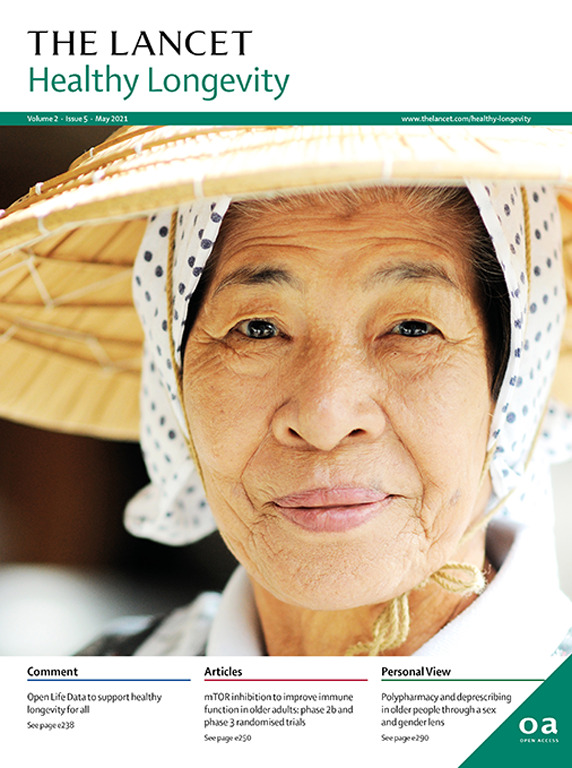停止绝经期激素治疗和骨折风险:巢式病例对照研究使用常规收集的初级保健数据。
IF 14.6
Q1 GERIATRICS & GERONTOLOGY
引用次数: 0
摘要
背景:绝经期激素治疗可降低女性骨折风险。然而,关于停止更年期激素治疗后风险的信息很少且不一致,没有关于女性年龄增长的长期骨折风险的信息。我们的目的是在停止治疗后尽可能长时间内对过去的使用者进行骨折风险的可靠估计。方法:我们使用来自临床实践研究数据链的英国初级和二级保健数据进行了一项嵌套病例对照研究,潜在队列为CPRD GOLD和Aurum。在1998年1月1日至2023年2月28日期间在初级保健诊所登记的40岁及以上的女性,并且有任何骨折的首次记录,在骨折指数日期与多达5名年龄相同且在同一全科诊所登记的无骨折史的女性对照进行匹配。绝经期激素治疗相关骨折风险评估使用条件logistic回归调整人口统计学、家族史、绝经期症状、合并症和其他药物。研究结果:共有648747名女性(来自Aurum数据库的500 692名和来自GOLD数据库的148 055名)在研究期间有首次骨折记录,与此前或同期没有骨折记录的2 357 125名女性相匹配。骨折病例的平均年龄为68.5岁(SD为14.0),少数民族占3.2%,年龄在80岁以上的患者约占1 / 4。140410例(21.6%)患者接受更年期激素治疗,中位时间为3.6年(IQR为1.3 -6·8),515917例(21.9%)对照组接受激素治疗,中位时间为3.9年(1.4 - 7.3)。与从未使用过的患者相比,目前使用的患者总体骨折风险降低(雌激素-孕激素比值比[OR] 0.76 [95% CI 0.74 - 0.78],雌激素-孕激素比值比[OR] 0.75[0.73 - 0.76]),停药后1-10年的骨折风险升高(雌激素-孕激素比值比[OR] 0.99[0.98 - 1.01],雌激素-孕激素比值比[OR] 1.06[1.05 - 1.08]),停药后10年以上的骨折风险再次降低(雌激素-孕激素比值比[OR] 0.93[0.91 - 0.94],雌激素-孕激素比值比[OR] 0.95[0.94 - 0.96])。风险水平因绝经期激素治疗类型和治疗持续时间而异。估计每1万名妇女中,雌激素-孕激素治疗后1-10年的额外骨折病例相当于绝经期激素治疗不足5年的14例和绝经期激素治疗5年或更长时间的5例。然而,在停药后10年多的时间里,我们估计接受雌激素-孕激素治疗不足5年的患者骨折病例减少了3例,接受雌激素-孕激素治疗超过5年的患者骨折病例减少了13例。解释:我们观察到停止绝经期激素治疗后骨折风险的衰减,这在最初的急剧上升后表现出来。骨折风险通常随着年龄的增长而增加,但在停止绝经期激素治疗后,骨折风险急剧增加,通常高于类似的从不使用激素的水平,然后相对于从不使用激素的人上升的速度较慢,与年龄较大的人相比又明显降低。我们的研究结果为研究人员提供了改善绝经期激素治疗后女性骨折风险结果的信息,也为医生和患者在开始或停止绝经期激素治疗前考虑提供了信息,特别是考虑到预期的中断后骨折风险急剧上升和骨折风险增加的时期。资助:国家卫生与保健研究所。本文章由计算机程序翻译,如有差异,请以英文原文为准。
Discontinuation of menopausal hormone therapy and risk of fracture: nested case–control studies using routinely collected primary care data
Background
Women benefit from reduced fracture risk while using menopausal hormone therapy. However, information on risks after stopping menopausal hormone therapy is scarce and inconsistent, with no information on longer-term fracture risk as women age. We aimed to produce robust estimates of fracture risk among past users for the longest possible period after discontinuing therapy.
Methods
We did a nested case–control study using UK primary and secondary care data from the Clinical Practice Research Datalink, with the underlying cohorts CPRD GOLD and Aurum. Women, aged 40 years and older, registered with a primary care practice between Jan 1, 1998, and Feb 28, 2023, and with a first record for any fracture, were matched at the fracture index date with up to five female controls with no fracture history, who were of the same age and registered at the same general practice. Menopausal hormone therapy-related fracture risks were assessed using conditional logistic regression adjusted for demographics, family history, menopausal symptoms, comorbidities, and other medications.
Findings
In total, 648 747 women (500 692 from Aurum and 148 055 from GOLD databases) with a first fracture record during the study period were matched to 2 357 125 women with no previous or contemporaneous fracture record. Age of average fracture cases was 68·5 years (SD 14·0), 3·2% were recorded as being from minority ethnic populations, and about a quarter of patients were older than 80 years. 140 410 (21·6%) cases used menopausal hormone therapy for a median of 3·6 years (IQR 1·3–6·8) and 515 917 (21·9%) controls used it for a median of 3·9 years (1·4–7·3). Compared with never-use, overall fracture risk was reduced for current use (oestrogen-only odds ratio [OR] 0·76 [95% CI 0·74–0·78], oestrogen–progestogen OR 0·75 [0·73–0·76]), became higher 1–10 years after discontinuation (oestrogen-only OR 0·99 [0·98–1·01], oestrogen–progestogen OR 1·06 [1·05–1·08]), but was again lower for more than 10 years post-cessation (oestrogen-only OR 0·93 [0·91–0·94], oestrogen–progestogen OR 0·95 [0·94–0·96]). Risk levels varied by menopausal hormone therapy type and by duration of treatment. Estimated extra fracture cases per 10 000 women-years 1–10 years after oestrogen–progestogen treatment were equivalent to 14 cases for less than 5 years menopausal hormone therapy exposure and five cases for 5 or more years of exposure. However, for more than 10 years after discontinuation, we estimated three fewer fracture cases for those on oestrogen–progestogen therapy for less than 5 years exposure and 13 fewer fracture cases for those with 5 or more years of exposure.
Interpretation
We have observed an attenuation of fracture risk after discontinuing menopausal hormone therapy, which manifests after an initial sharp rise. Fracture risk generally increases with age, but after discontinuation of menopausal hormone therapy, fracture risk increases steeply, usually to above the levels of comparable never-users, and then rises less quickly relative to never-users to become again notably reduced by comparison in older age. Our findings provide information for researchers looking to improve fracture risk outcomes for women after discontinuing menopausal hormone therapy, and for doctors and their patients to consider before commencing or stopping menopausal hormone therapy, especially regarding expected steep post-discontinuation rises in fracture risk and periods of enhanced fracture risk.
Funding
National Institute for Health & Care Research.
求助全文
通过发布文献求助,成功后即可免费获取论文全文。
去求助
来源期刊

Lancet Healthy Longevity
GERIATRICS & GERONTOLOGY-
CiteScore
16.30
自引率
2.30%
发文量
192
审稿时长
12 weeks
期刊介绍:
The Lancet Healthy Longevity, a gold open-access journal, focuses on clinically-relevant longevity and healthy aging research. It covers early-stage clinical research on aging mechanisms, epidemiological studies, and societal research on changing populations. The journal includes clinical trials across disciplines, particularly in gerontology and age-specific clinical guidelines. In line with the Lancet family tradition, it advocates for the rights of all to healthy lives, emphasizing original research likely to impact clinical practice or thinking. Clinical and policy reviews also contribute to shaping the discourse in this rapidly growing discipline.
 求助内容:
求助内容: 应助结果提醒方式:
应助结果提醒方式:


